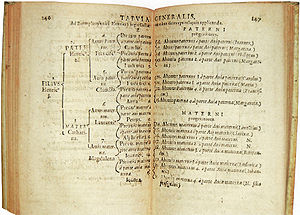
Back آننتافل Arabic Åhnentåfl BAR Ahnentafel Catalan Vývod (genealogie) Czech Anetavle Danish Ahnentafel German Ahnentafel Spanish Esipolvitaulu Finnish Numérotation de Sosa-Stradonitz French Ahnentafel Galician
This article needs additional citations for verification. (August 2018) |


An ahnentafel (German for "ancestor table"; German: [ˈʔaːnənˌtaːfəl]) or ahnenreihe ("ancestor series"; German: [ˈʔaːnənˌʁaɪə]) is a genealogical numbering system for listing a person's direct ancestors in a fixed sequence of ascent. The subject (or proband) of the ahnentafel is listed as No. 1, the subject's father as No. 2 and the mother as No. 3, the paternal grandparents as No. 4 and No. 5 and the maternal grandparents as No. 6 and No. 7, and so on, back through the generations. Apart from No. 1, who can be male or female, all even-numbered persons are male, and all odd-numbered persons are female. In this schema, the number of any person's father is double the person's number, and a person's mother is double the person's number plus one. Using this definition of numeration, one can derive some basic information about individuals who are listed without additional research.
This construct displays a person's genealogy compactly, without the need for a diagram such as a family tree. It is particularly useful in situations where one may be restricted to presenting a genealogy in plain text, for example, in emails or newsgroup articles. In effect, an ahnentafel is a method for storing a binary tree in an array by listing the nodes (individuals) in level-order (in generation order).
The ahnentafel system of numeration is also known as the Eytzinger Method, for Michaël Eytzinger, the Austrian-born historian who first published the principles of the system in 1590;[1] the Sosa Method, named for Jerónimo (Jerome) de Sosa, the Spanish genealogist who popularized the numbering system in his work Noticia de la gran casa de los marqueses de Villafranca in 1676;[2] and the Sosa–Stradonitz Method, for Stephan Kekulé von Stradonitz, the genealogist and son of chemist Friedrich August Kekulé, who published his interpretation of Sosa's method in his Ahnentafel-atlas in 1898.[3]
"Ahnentafel" is a loan word from the German language, and its German equivalents are Ahnenreihe and Ahnenliste. An ahnentafel list is sometimes called a "Kekulé" after Stephan Kekulé von Stradonitz. A variant of is known in French as Seize Quartiers.
- ^ Eytzinger, Michael, Thesaurus principum hac aetate in Europa viventium, quo progenitores eorum... simul ac fratres et sonores inde ab origine reconduntur... usque ad annum..., Cologne: G. Kempensem, 1590 (1591). Note: In commentaries, his surname may appear in variant forms, including: Aitsingeri, Aitsingero, Aitsingerum, Eyzingern.
- ^ Jouniaux, Léo, Généalogie : pratique, méthode, recherche, Quercy: Seuil, 2006, pp. 44–45.
- ^ Kekulé von Stradonitz, Stephan, Ahnentafel-atlas. Ahnentafeln zu 32 Ahnen der Regenten Europas und ihrer Gemahlinnen, Berlin: J. A. Stargardt, 1898–1904. This volume contains 79 charts of the sovereigns of Europe and their wives.
© MMXXIII Rich X Search. We shall prevail. All rights reserved. Rich X Search